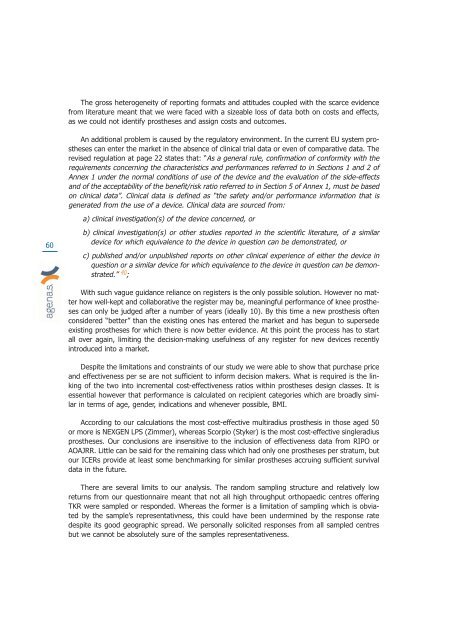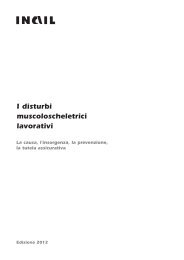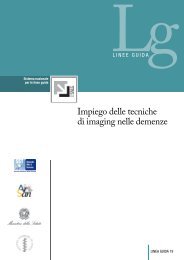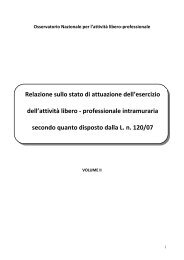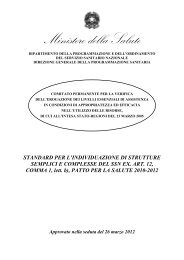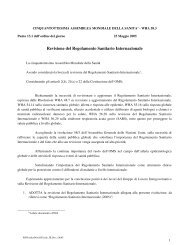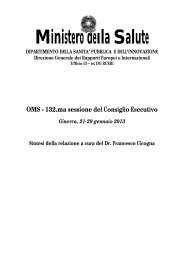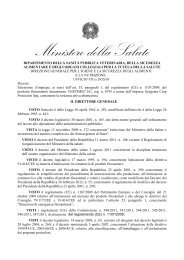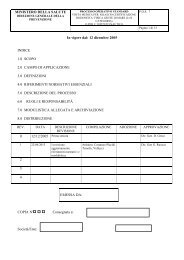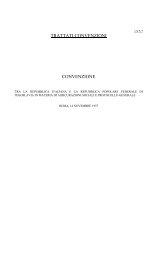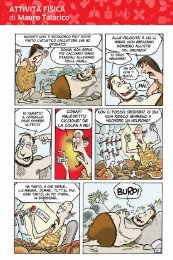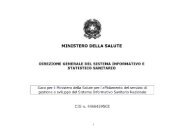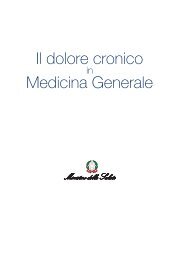hta_ knee intro.qxp - Ministero della Salute
hta_ knee intro.qxp - Ministero della Salute
hta_ knee intro.qxp - Ministero della Salute
Create successful ePaper yourself
Turn your PDF publications into a flip-book with our unique Google optimized e-Paper software.
60<br />
The gross heterogeneity of reporting formats and attitudes coupled with the scarce evidence<br />
from literature meant that we were faced with a sizeable loss of data both on costs and effects,<br />
as we could not identify prostheses and assign costs and outcomes.<br />
An additional problem is caused by the regulatory environment. In the current EU system prostheses<br />
can enter the market in the absence of clinical trial data or even of comparative data. The<br />
revised regulation at page 22 states that: “As a general rule, confirmation of conformity with the<br />
requirements concerning the characteristics and performances referred to in Sections 1 and 2 of<br />
Annex 1 under the normal conditions of use of the device and the evaluation of the side-effects<br />
and of the acceptability of the benefit/risk ratio referred to in Section 5 of Annex 1, must be based<br />
on clinical data”. Clinical data is defined as “the safety and/or performance information that is<br />
generated from the use of a device. Clinical data are sourced from:<br />
a) clinical investigation(s) of the device concerned, or<br />
b) clinical investigation(s) or other studies reported in the scientific literature, of a similar<br />
device for which equivalence to the device in question can be demonstrated, or<br />
c) published and/or unpublished reports on other clinical experience of either the device in<br />
question or a similar device for which equivalence to the device in question can be demonstrated.”<br />
40 ;<br />
With such vague guidance reliance on registers is the only possible solution. However no matter<br />
how well-kept and collaborative the register may be, meaningful performance of <strong>knee</strong> prostheses<br />
can only be judged after a number of years (ideally 10). By this time a new prosthesis often<br />
considered “better” than the existing ones has entered the market and has begun to supersede<br />
existing prostheses for which there is now better evidence. At this point the process has to start<br />
all over again, limiting the decision-making usefulness of any register for new devices recently<br />
<strong>intro</strong>duced into a market.<br />
Despite the limitations and constraints of our study we were able to show that purchase price<br />
and effectiveness per se are not sufficient to inform decision makers. What is required is the linking<br />
of the two into incremental cost-effectiveness ratios within prostheses design classes. It is<br />
essential however that performance is calculated on recipient categories which are broadly similar<br />
in terms of age, gender, indications and whenever possible, BMI.<br />
According to our calculations the most cost-effective multiradius prosthesis in those aged 50<br />
or more is NEXGEN LPS (Zimmer), whereas Scorpio (Styker) is the most cost-effective singleradius<br />
prostheses. Our conclusions are insensitive to the inclusion of effectiveness data from RIPO or<br />
AOAJRR. Little can be said for the remaining class which had only one prostheses per stratum, but<br />
our ICERs provide at least some benchmarking for similar prostheses accruing sufficient survival<br />
data in the future.<br />
There are several limits to our analysis. The random sampling structure and relatively low<br />
returns from our questionnaire meant that not all high throughput orthopaedic centres offering<br />
TKR were sampled or responded. Whereas the former is a limitation of sampling which is obviated<br />
by the sample’s representativness, this could have been undermined by the response rate<br />
despite its good geographic spread. We personally solicited responses from all sampled centres<br />
but we cannot be absolutely sure of the samples representativeness.


